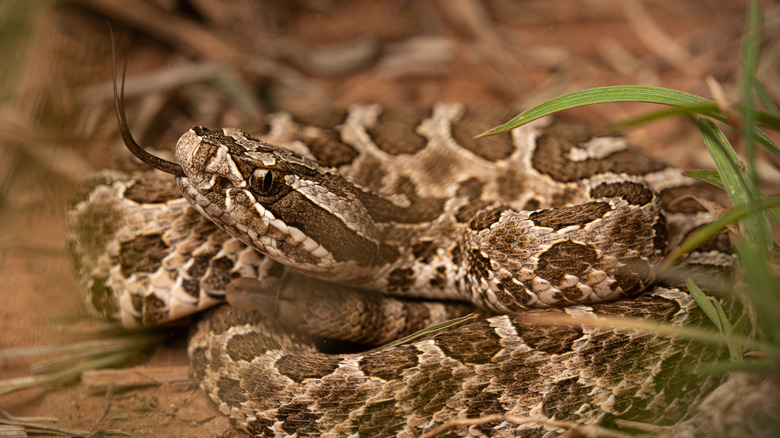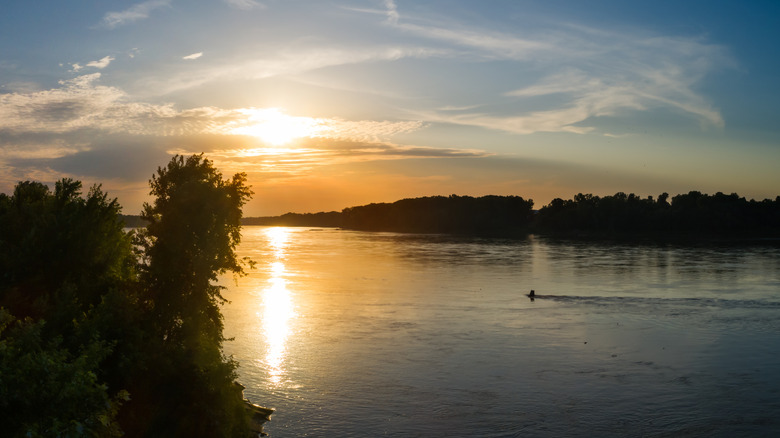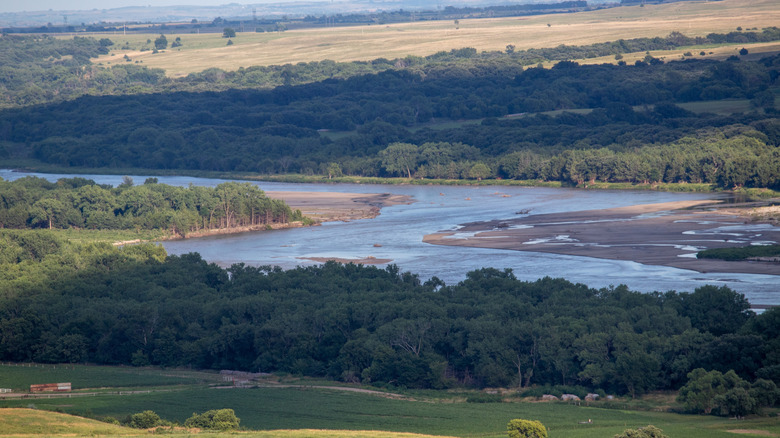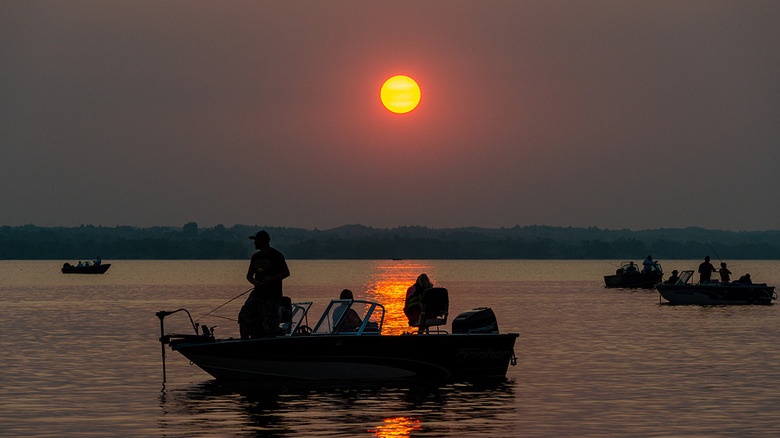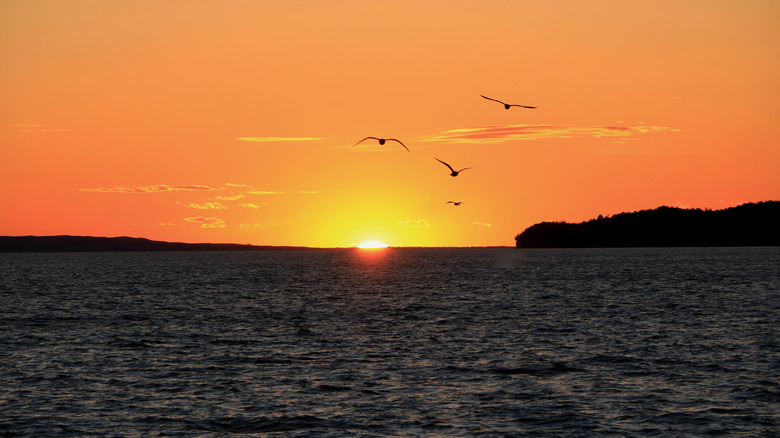These Snake-Filled Lakes And Rivers In Nebraska Aren't For The Faint Of Heart
Nebraska is home to 29 different species of snakes. This should come as no surprise, considering the state is filled with prairies and semi-arid terrains, which are common habitats for these reptiles. However, Nebraska's rivers and lakes are also preferred by snakes — including some venomous ones. And although the term "snake-filled" might sound nightmare-inducing, it's nothing to cancel your trip about. That said, visitors to areas like the Missouri River — where Nebraska's history-filled Indian Cave State Park is located — or the Lewis and Clark Lake should indeed exert some caution.
That said, it's important to remember that snakes are a natural part of the ecosystem, with water snakes being a common occurrence near Nebraska's waters. And while these species are completely harmless, four venomous species (the prairie, timber and western Massasauga rattlesnakes, and the copperhead) can indeed be found in the Cornhusker State.
As such, any time you head into the great outdoors, make sure to wear the appropriate footwear, be aware of your surroundings, and always give snakes plenty of space. Most of them will not attack unless you bother them. With that being said, let's take a look at some of the lakes and rivers in Nebraska that require you to be extra vigilant during the coming summer months.
The Missouri River's snakes
Stretching all the way into the border with South Dakota, the Missouri River is a favorite of snakes as well as outdoor enthusiasts. In fact, the river is known to have various snake species — both venomous and non-venomous. However, it's not overwhelmingly "snake-filled" in a way that would be dangerous to humans — it's just that the river crosses through many different state parks and recreation areas with suitable snake habitats, like wetlands.
For instance, the Missouri National Recreational River area (MNRR) — a popular place among nature and outdoor lovers as well as history buffs — is home to at least 12 different snake species. Some of these include racer snakes, northern water snakes, garter snakes, milk snakes, and both the eastern and western hog-nosed snake, among others.
The prairie rattlesnake, the northern copperhead and timber rattlesnake also call the river and surrounding areas their home. Although, according to the National Parks Service, "the likelihood of an average visitor even seeing a venomous snake at the MNRR, let alone being bitten by one, is extremely small." Other areas along the Missouri River where you might encounter these species include the Pelican Point State Recreation Area, the Ponca State Park, and the Niobrara State Park, located close to Nebraska's very own little "Everglades" town.
The Snake River in the Sandhills and the Niobrara River
Located in the Sandhills, America's windswept sandy secret, the Snake River is known for its diverse wildlife — rattlesnakes included. The Snake River's rocky and grassy areas, sand dunes, and riverside cliffs are all ideal habitats for "rattlers." For humans, it's also a great place for enjoying some fishing as well as boating, especially at the Merritt Reservoir. Along with that, visitors can also enjoy some hiking, bird watching, and camping in the area, as well as visit the beautiful Snake River Falls nearby.
The Snake River eventually flows into the Niobrara River, which is also an oasis for rattlesnakes. Specifically, the prairie rattlesnake. If you do decide to venture into the forests near the river you'll likely run into the ring-necked snake. Meanwhile, other non-venomous species near and around the Niobrara River include bull snakes and red-sided garter snakes, just to name a few.
The Niobrara National Scenic River offers a variety of outdoor activities for visitors such as canoeing, kayaking, and tubing. Beyond the river, the area is also great for hiking, biking, camping, and wildlife and bird watching. Fort Niobrara National Wildlife Refuge, which lies 15 minutes from the town of Valentine, a wildly underrated adventurer's paradise, is also worth a visit. And, as long as you stay on the marked trails, rattlesnakes and other slithering creatures shouldn't pose a threat to you or your family.
Calamus Reservoir and State Recreation Area
A popular place for outdoor enthusiasts also in Nebraska's Sandhills is the Calamus State Recreation Area. You'll find the reservoir here — a huge lake covering more than 5,100 acres of land — as well as some of the state's venomous snake species, such as the western Massasauga rattlesnake.
Although the sheer notion of running into a rattlesnake might sound scary, remember that actually finding one is unlikely. If you're spending time near the water, you're actually most likely to run into harmless garter snakes swimming around in search of frogs and insects. Other species that can be spotted at the recreation area include ring-necked snakes and bull snakes, among others.
Snakes aside, the Calamus State Recreation Area and its beautiful reservoir are also perfect for camping, hiking, boating, and fishing. You'll also find a fish hatchery offering educational activities and guided lake tours within the area, which makes it a great destination for both kids and adults. If you're visiting Calamus, make sure to head over to Burwell, too, which is located just 10 minutes away.
The Lewis and Clark Lake
Located between South Dakota and Nebraska, and stretching all the way into the Missouri River, the Lewis and Clark Lake offers visitors many outdoor activities to enjoy. Some of the most popular ones include boating, kayaking, and fishing. The area is also perfect for swimming as well as camping.
Those interested in visiting can do so while driving on South Dakota's breathtaking Native American Scenic Byway, as the journey ends right in the town of Yankton, just 30 minutes from the lake. Alternatively, the lake can also be reached from the Nebraska town of Crofton, which is a quick 40-minute drive away.
As for the snakes you can find at the Lewis and Clark Lake, you need to be especially cautious of the prairie rattlesnake. These are typically found near rocky outcrops. Other snake residents — such as the summer-loving garter snakes, plains milk and rat snakes, and the common watersnake — are completely harmless. They mostly feed on smaller animals such as rodents, birds, or amphibians. However, in case you do happen to run into one of these snakes, try to stay away from them (especially the rattlesnakes) and you'll be fine. Other wildlife common in the area include ospreys and eagles, ducks, and even elk.
The Lake McConaughy State Recreation Area
Another popular place for outdoor enthusiasts in the Lake McConaughy State Recreation Area (or Lake Mac for short). Located just 10 minutes from Ogallala, the 30,000 acre reservoir is also popular among several species of snakes — including the prairie rattlesnake. Other species present are the northern watersnake, bull snakes, and, of course, garter snakes.
Lake Mac is also known for its diverse fish population, making it a great spot for fishing. Boating and kayaking are also big here, especially since Lake Ogallala is located nearby. And no summer trip to any lake would be complete without enjoying some swimming, so of course that is available here. Better yet, you will also find campgrounds and picnic areas for a complete summer experience. The lake tends to get crowded during the summer, but as long as you book your camping stay in advance, you'll still be able to enjoy the lake's beaches and its waters in spite of tourists.
As a result, people tend to be much more of a bigger threat to your enjoyment of Lake Mac than the snakes. The same can be said for other lakes and rivers in Nebraska, like Branched Oak Lake near Lincoln. However, as long as you remember to be respectful toward these reptiles, you'll be out of harm's way while enjoying your summer vacation.
